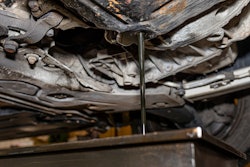
Bendix has released a technical bulletin addressing troubleshooting and maintaining air dryer systems and their key components.
According to Bendix, no matter what fuels your truck, more components and technologies than ever are connected to the compressed air system. Brakes, emissions controls, automated manual transmissions, and advanced driver assistance systems (ADAS) all require a dependable supply of clean and dry air to optimize their safe and efficient operation.
“Rule number one is keeping moisture, oil aerosols, and other contaminants out of your air system to the greatest degree possible, since they present a corrosion hazard to some of the crucial components within,” says Jason Kolecki, Bendix director of marketing and customer solutions, Air Supply and Drivetrain. “Oil, in particular, can deteriorate seals, cause leaks, and damage valves and brake chamber diaphragms. There really is a lot at stake.”
Checking for moisture in the air dryer system begins with opening the reservoirs’ drain valves. Even if you don’t find moisture in the system, inspect all the air lines for damage like chafing, and check the air dryer mounting bolts for tightness and torque as specified in the manufacturer’s service data sheet.
If water is present, Bendix says first take into account whether there have been significant temperature changes within the previous 24 hours. Ambient shifts of more than 30ºF can cause a temporary accumulation of moisture, so if that’s the case, continue to operate the vehicle as normal: The small amount of water that may have condensed due to the temperature shift will be reabsorbed by the dry air once the vehicle is in operation. Check for moisture again after a week, preferably after a period without significant temperature changes, the company says.
If temperature swings don’t seem to be a factor, Bendix says then investigate whether any external air has been applied to the system. If it has, drain all the reservoirs and purge tanks. Then restart the vehicle and allow the air system pressure to build to the governor cutout pressure. Once the system reaches proper pressure, operate the vehicle normally and recheck after one week for water in the reservoirs.
In the absence of external air as a factor, refer to the air dryer’s service data sheet to confirm that it’s mounted in the correct location, and that the discharge line is the right length. Correct any errors with the mounting or plumbing, ensuring that the discharge line from the compressor to the air dryer slopes continuously downward to the air dryer inlet, with no droops or loops to act as water traps.
Next, malfunctioning valves within an air dryer system have noticeable effects, such as air loss. For example, if charging the tanks takes three or four minutes as opposed to one or two, then the system might be leaking. Bendix says the same is true if it’s charging more often, which also affects the life of the dryer cartridge. Bendix recommends proactive upkeep on purge valves and delivery check valves to keep the system in good health.
“We suggest replacing the purge valve assembly whenever the air dryer cartridge is replaced, as a best practice in preventive maintenance,” says Brian Screeton, manager of sales technical training at Bendix. “This practice will address several potential purge valve issues, including leakage or lack of pressure building due to purge valve seal wear; ‘popping’ of the purge valve due to intermittent sticking; and the loss of engine turbocharger boost during the purge cycle due to leakage in the turbo cutoff valve.”
Signs of a failing delivery check valve can include a lack of pressure buildup due to the valve sticking in the closed position, and rapid cycling or loss of pressure during the purge cycle, which would be caused by a leak in the valve. Bendix recommends replacing the air dryer system’s delivery check valve with every other cartridge replacement – and how often is that? The answer varies.
Air dryer technology has evolved – which means that service intervals have too.
“Regardless of the type or brand of compressor the vehicle is equipped with, we recommend air dryer cartridge replacement every six to 12 months for vehicles with a high or sensitive air demand – like city transit buses, off-road vehicles, or those with an automatic manual transmission (AMT). We recommend replacement every 12 to 24 months for those with a standard air demand, such as a line haul vehicle,” Screeton says. “Always follow the truck manufacturer’s published maintenance recommendations, as they may require more frequent maintenance intervals.”
Fleets can determine the condition of the air dyer by draining the reservoirs and observing the liquid that is discharged.
Screeton adds, “If you find excessive moisture – or even oil mixed with water – present in the reservoir, then the air dryer cartridge likely needs to be replaced. Bendix recommends this check be done once a month.”
More frequent intervals may be required depending on a vehicle’s age, compressor condition, and operating environment, and Bendix always recommends using an oil-coalescing cartridge such as the Bendix PuraGuard. The company says standard cartridges may be replaced with oil-coalescing cartridges, but fleets should always change out oil-coalescing cartridges with like replacements.
On trucks equipped with high-air-usage components like lift axles, central tire inflation, bulk unloading, or buses whose normal route demands repetitive pneumatic operations like kneeling and door actuation, the compressor can often exceed its recommended duty cycle. This leads to higher discharge temperatures and can increase the chances of oil aerosols passing through the air dryer before condensing downstream.
Air system maintenance is vital, but it doesn’t need to be complex: Bendix says with an understanding of the interconnected components, use of oil-coalescing air dryer cartridges, and an established schedule for checkups, it’s a breeze.










